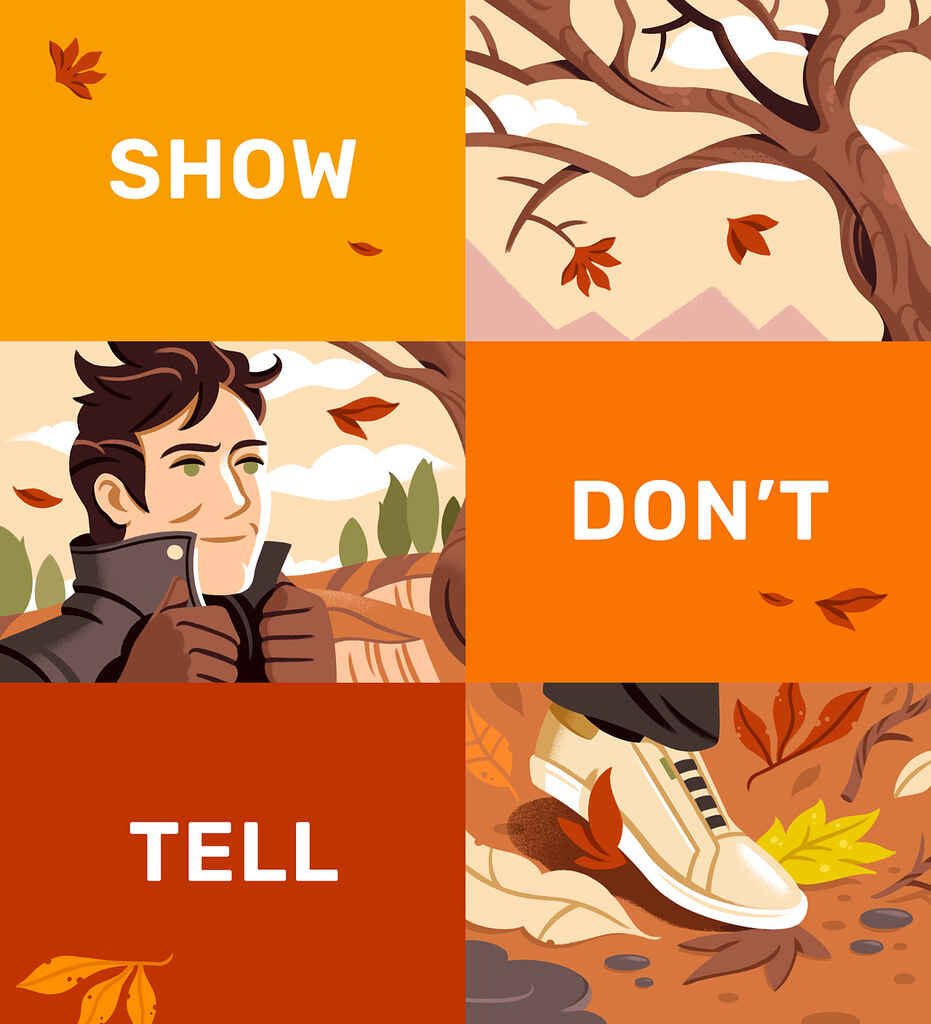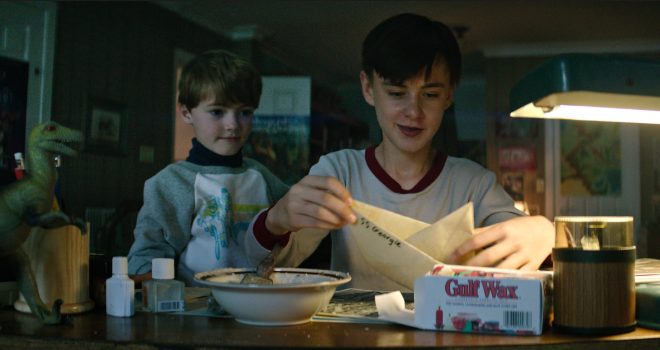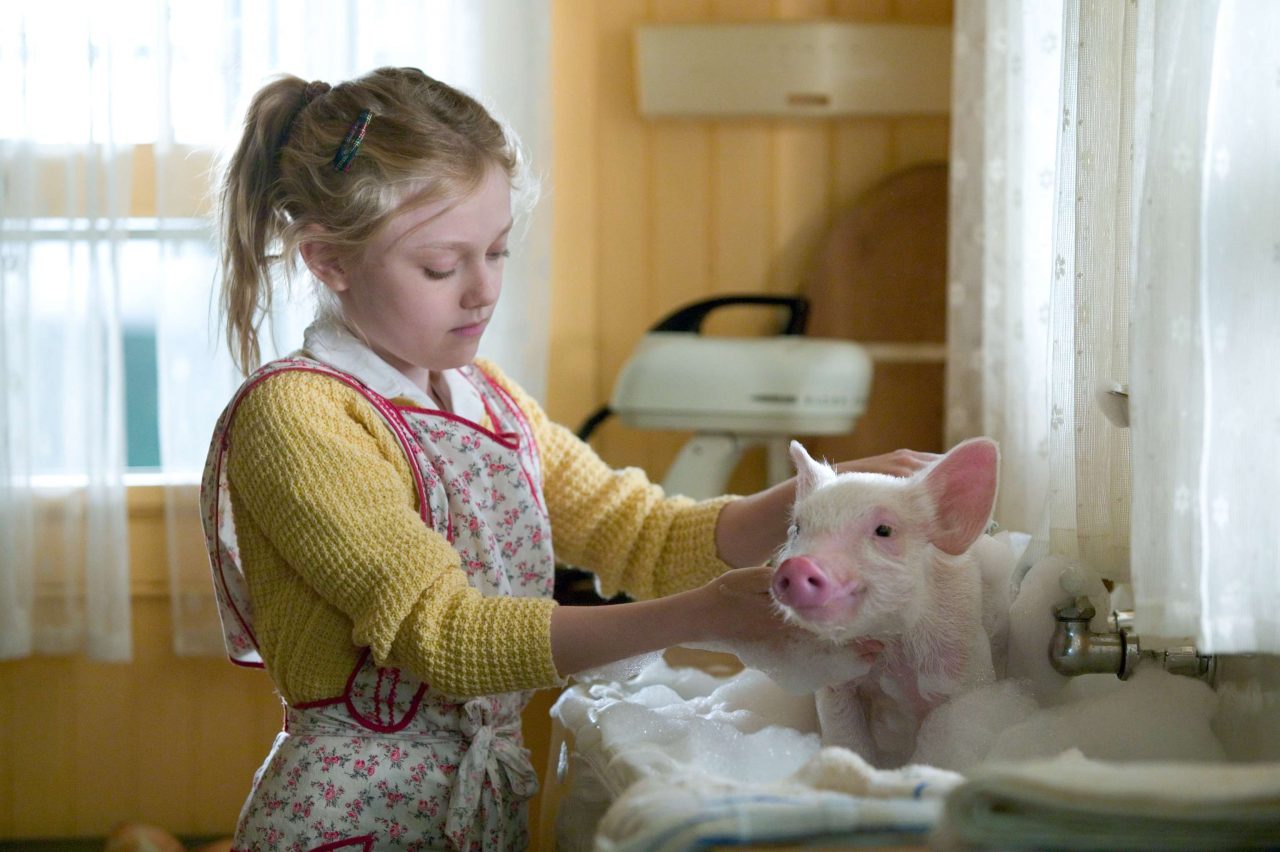Last updated on Oct 15, 2025
Show, Don't Tell: Tips and Examples of The Golden Rule
Martin Cavannagh
Head of Content at Reedsy, Martin has spent over eight years helping writers turn their ambitions into reality. As a voice in the indie publishing space, he has written for a number of outlets and spoken at conferences, including the 2024 Writers Summit at the London Book Fair.
View profile →Show, don’t tell is a writing technique in which story and characters are related through sensory details and actions rather than exposition. It fosters a more immersive writing style for the reader, allowing them to “be in the room” with the characters.
In his oft-repeated quoted, Anton Chekhov said, “Don’t tell me the moon is shining. Show me the glint of light on broken glass."
In short: showing illustrates, while telling merely states. Here’s a quick example:
Showing: As his mother switched off the light and left the room, Michael tensed. He huddled under the covers, gripped the sheets, and held his breath as the wind brushed past the curtain.
Telling: Michael was terribly afraid of the dark.
In the “showing” example, rather than merely saying that Michael is afraid of the dark, we’ve put him in a situation where his experience of that fear takes center stage. The reader can deduce the same information they’d get from the “telling” example but in a much more compelling way.
In this post, we'll show you why Show Don't Tell is the most popular "rule" in creative writing and show you how you can add some "showing" skills to your toolkit.

FREE COURSE
Show, Don't Tell
Master the golden rule of writing in 10 five-minute lessons.
Drawing the readers in with action
Showing also helps develop characters in a way that isn't just listing their traits. For instance, rather than telling your readers that “Gina was selfish and immature,” you could show this side of her by writing a scene where she whines about how everyone forgot her half-birthday. Or if you have a character who’s extremely determined, show her actually persisting through something — don’t just say “she was persistent.”
Q: What are effective techniques for incorporating exposition into a story without disrupting the flow or pacing?
Suggested answer
I see poorly integrated facts in nonfiction all the time. You'll be reading beautiful prose and all of a sudden you're hit with what reads like a copy-and-pasted section of Wikipedia. Writers need to take the facts and make them their own. That means finding ways to make them vivid and immediate to the reader and weaves them into the narrative.
Susanna is available to hire on Reedsy ⏺
The best way to get exposition in is through dialogue. The caveat, of course, is to be careful that it comes across naturally. For instance, if your characters are telling each other things they would know, the reader will know you're only doing that to get the information to the reader, which will greatly reduce their suspension of disbelief.
The second best way, in my opinion, is through thoughts. Again, though, the character needs to think things they would actually think in their situation. For instance, in a fantasy novel, if you drop a big infodump of the world's setting, or the way machines work, or how various monsters are classified, etc., it won't be believable because there's no reason for the character to think things they already know. You could show them working through various possibilities in their mind, coming to correct conclusions, that kind of thing, but the process has to appear honest. Always assume your reader is intelligent, and is capable of sensing expositional shortcuts.
Brett is available to hire on Reedsy ⏺
When done right, showing draws readers into the narrative with truly immersive description. It contributes to story development but also leaves certain things up to the reader’s interpretation, which is much more interesting than making everything explicit. (Though of course, you can still use language to alter their perception).
The bottom line: telling might be quicker, and it’s certainly necessary to have some telling in every story (more on that later), but showing should almost always be your prime strategy.
🖊️
Which contemporary author are you?
Find out which of today's greats is your writerly match. Takes one minute!
All right, that’s enough theory for now! Let’s talk about how you can show, not tell, in your own work. Here are five key tips on how to show rather than tell in a story
4 Practical 'Show, Don’t Tell' Tips
Let's start with one of the most important aspects of storytelling...
Tip #1. Create a sense of setting
One of the best ways to show rather than tell is to create a sense of setting. You can do this by writing about how characters perceive and interact with their surroundings, weaving plenty of sensory details and occasional action into the scene. This is a particularly good way to lend immediacy to your story, as the reader should be able to imagine themselves in that very setting.
Q: What techniques can authors use to personify nature and make it feel like an active character in their story?
Suggested answer
Write it so it feels like it has agency of its own—not like it actually does, but just so it feels like if it wanted to exert some form of will on the human characters, it could. That's a little nebulous, I know, but it's neither an easy thing to do nor describe. 🙂
Brett is available to hire on Reedsy ⏺
Telling: I walked through the forest. It was already Fall and I was getting cold.
Showing: The dry orange leaves crunched under my feet as I pulled the collar up on my coat.

Tip #2. Use dialogue to show character
In addition to setting, you can also use dialogue to demonstrate story elements beyond the surface conversation. A character’s speech will tell the reader a lot about them, especially when they’re first being introduced.
Q: What are some techniques authors can use to introduce characters naturally through dialogue?
Suggested answer
When you're going to create a character through dialogue, what you want to do is provide the reader with information about this individual without interrupting the action for exposition.
One good way to do that is to think about how actual people reveal themselves in conversation: through what they say, the cadence of their speech, and what they focus on. Instead of telling us about what a character is sure, nervous, or resentful of, you can make those qualities evident in what they say.
A certain sort of character might answer quickly or deflect, while an unsure one might lie or offer more questions than answers. You can also include context of hinting—perhaps another character does something in response to an unexpected comment, or someone uses a nickname that suggests history. This allows the dialogue not just to define who the character is, but also how they exist in relationships with the world around them. It's generally more engaging to give little hints than to tell everything.
By piling personality, background, and relationships onto conversations, you create a sense of authenticity so that readers feel they're reading about a real person rather than getting a synopsis.
John is available to hire on Reedsy ⏺
Dialogue is one of the most powerful ways to introduce your characters and bring them to life for readers. When done well, it reveals personality, relationships, and motivations—all in a way that feels natural and engaging. Here are a few techniques to make character introductions through dialogue memorable, with examples from authors I’ve worked with.
Show personality through speech patterns
The way a character speaks—their tone, choice of words, and rhythm—can reveal a lot about who they are. In Losing Juliet by June Taylor, the dialogue between two adult female characters is a perfect example. One character is guarded and precise, while the other’s tone is more casual and assertive. This contrast instantly tells us about their personalities and sets up their complex dynamic. When editing, I often help authors create unique speech patterns that make each character’s voice distinctive.
Reflect relationships through dialogue
How characters speak to each other reveals their relationship dynamics. In Losing Juliet, Taylor uses subtle hints in the dialogue to convey past secrets and tension without spelling it all out. Readers sense the history and conflict between the characters, making the dialogue feel rich and layered. When I work with authors, I encourage exploring these nuances in relationships, showing rather than telling.
Reveal motivation through subtext
Great dialogue often goes beyond what’s explicitly said. In The Hanged Man Rises by Sarah Naughton, the children’s dialogue is filled with innocence and curiosity, yet it often hints at deeper fears and uncertainties. This subtle layer adds intrigue without needing direct exposition. I frequently work with authors to find opportunities for subtext, letting readers read between the lines to discover characters’ hidden motivations.
Show conflict and tension
Conflict in dialogue can reveal a character’s core traits. In The Hanged Man Rises, Naughton’s children’s dialogue shows both their vulnerability and resilience, heightening the story’s suspense. In Losing Juliet, conversations between the protagonists highlight simmering anger and unresolved issues, offering readers a glimpse of what drives each character. When editing, I encourage authors to think about how characters might speak differently under pressure—revealing who they are when emotions run high.
Balance dialogue with actions and reactions
Dialogue is most impactful when paired with physical cues. In Losing Juliet, Taylor often uses gestures and subtle actions to deepen the impact of what’s said (or left unsaid). These small cues add depth, creating a more immersive experience. I often advise authors to integrate these details, as they can make dialogue feel more real and relatable.
Reflect character growth in speech
As characters evolve, so should their dialogue. In The Hanged Man Rises, Naughton’s young characters’ dialogue changes as they face challenges, reflecting their growth over the course of the story. This shift makes their journey feel authentic, and I often encourage authors to consider these changes as they develop characters’ arcs.
Shelley is available to hire on Reedsy ⏺
How much or how little a character "speaks" says a lot about them. A dialect can also reveal where they are from. Broken English or a stutter can also say a lot. Dialogue is a great way to "show" and not "tell."
Melody is available to hire on Reedsy ⏺
The main thing to get across when introducing characters through dialogue is to write it so it feels natural. Constantly ask yourself if the way you're making them speak is the way regular people in those circumstances would speak. If it sounds too stilted or infodump-y, that's going to distance your reader from the character because they'll feel unreal, manufactured—just there to move the plot along.
Brett is available to hire on Reedsy ⏺
Do they use long sentences and polysyllabic words or do they prefer short, punchy replies? Are there likely to use slang and call an authority figure “dude” or “fam” or will they address them respectfully as “Mr. So-and-So”?

NEW REEDSY COURSE
How to Write a Novel
Enroll in our course and become an author in three months.
Tip #3. If in doubt, always describe action
“Telling” almost always grinds your narrative momentum to a halt. Imagine having to describe the setting every time your characters enter a new space — any pace you had built in your chapter would be destroyed. However, it’s still important to evoke the setting and put your scene in context. And that’s where showing action comes in handy.
Let’s say you start your scene with your character walking through St Mark’s Square in Venice. Instead of describing the pigeons, the tourists and the layout of the space, you can evoke it through action:
He was late. St Mark’s clocktower had struck one and Enzo found himself pushing against the tide of tourists milling towards the cafes lining the Piazza San Marco. A clump of pigeons scattered in front of him.
Through action, you’re able to describe the setting of the scene while also maintaining your story’s forward motion.
Tip #4. Use strong details, but don’t overdo it
Strong, vivid details are crucial to the process of showing. However, that doesn’t mean you should include too many details, especially those that are overly embellished. This kind of excessively ornate language can be just as bad as “telling” language that’s too basic, as it may cause the reader to lose interest in your super-dense prose.
Too much detail: The statue felt rough, its aged facade caked with dust and grime as I weighed it in my hand, observing its jagged curves and Fanta-colored hue.
Just right: It was heavier than it looked. Some of the orange facade crumbled in my hand as I picked it up.
Q: What are the most common craft mistakes new authors make?
Suggested answer
One of the biggest mistakes I see from new authors is that they finish writing their manuscript and then they think they are done and ready for an editor to go through and review.
Writers need to be their own editors first. Because there are so many potential new authors every day, it's imperative that writers go back and edit their work thoroughly. That means reading, and rereading what they've written to understand how their characters develop through their novel, or how the topics that they brought up in chapter two are refined and built upon in chapter nine. Through that reading process, writers should be editing their work as they find pieces that aren't strong enough or need to be altered to make a better overall manuscript.
Matt is available to hire on Reedsy ⏺
The most common writing mistake I see from first-time authors is cramming too much into the first chapter. Your first chapter is a meet and greet, where you establish credibility, likability, and optimism that the book is worth the reader's time. Hook the reader, show your personality, but don't dump all your knowledge on them at the beginning of the book. Take them on an interesting, helpful journey,
Mike is available to hire on Reedsy ⏺
Strike the right balance by alternating between simple and complex sentences and ideas, and different types of sensory detail, so the reader doesn’t get overloaded on one type.
'Show, Don’t Tell' Examples
To break down this technique even further, here are a few additional "show, don't tell" examples of authors showing rather than telling in their writing. If you want to analyze even more examples of this tactic, just crack open the nearest novel! Pretty much every work of fiction involves showing, and observing the tactics of successful authors is one of the best ways to learn for yourself.
Example #1. The Handmaid’s Tale by Margaret Atwood
I once had a garden. I can remember the smell of the turned earth, the plump shapes of bulbs held in the hands, fullness, the dry rustle of seeds through the fingers. Time could pass more swiftly that way. Sometimes the Commander’s Wife has a chair brought out, and just sits in it, in her garden. From a distance it looks like peace.
This passage uses various senses (smell, touch, and sound) to recreate the atmosphere of Offred’s old garden, romanticizing the act of gardening to show that she misses those days. It also connects that peaceful past time to the present day, implying that many people no longer feel at peace, including the Commander’s Wife.
Q: How can authors protect their rights when publishing, especially in the age of AI?
Suggested answer
I don't think anyone can fully protect themselves. If you act in good faith you will find that most other people will do the same. There will always be rogues, but selling books is hard enough if you are the real author, even harder if you have stolen it.
Andrew is available to hire on Reedsy ⏺
Example #2. It by Stephen King
In this early scene, young Georgie runs after his toy boat as he is unwittingly being lured by a malevolent force.
Now here he was, chasing his boat down the left of Witcham Street. He was running fast but the water was running faster and his boat was pulling ahead. He heard a deepening roar and saw that fifty yards farther down the hill the water in the gutter was cascading into a storm drain that was still open. It was a long dark semi-circle cut into the curbing, and as Georgie watched, a stripped branch, its bark as dark and glistening as sealskin, shot into the storm drain’s maw.
King renders the fast-running rivulets of a rainy day by having Georgie run alongside them, unable to keep up. Then he sees the storm drain, which King aptly calls a “maw” (a spot-on metaphor), and its threat is heightened by the sound of its “deepening roar” and the fact that it swallows an entire branch. Needless to say, poor Georgie’s boat doesn’t stand a chance.

Example #3. Gone Girl by Gillian Flynn
In this scene, a suburban husband awakens to the sound of his wife’s cooking.
My morning breath warmed the pillow, and I changed the subject in my mind. Today was not a day for second-guessing or regret, it was a day for doing. Downstairs, I could hear the return of a long-lost sound: Amy making breakfast. Banging wooden cupboards (rump-thump!), rattling containers of tin and glass (ding-ring!), shuffling and sorting a collection of metal pots and iron pans (ruzz-shuzz!). A culinary orchestra tuning up, clattering vigorously toward the finale.
This passage starts off fairly simple, building up to the grand metaphor of the kitchen noises as a “culinary orchestra.” It’s also noteworthy for its use of onomatopoeia, which is a great tactic for “showing” sound.
However, this passage isn’t just what Nick hears: it’s also what he feels (“my morning breath warmed the pillow”) and thinks (“I changed the subject in my mind”). The intimate description pulls the reader in, and the passage's rhythm (quite literally!) keeps them engaged.
🎵
Tell us about your book, and we'll give you a writing playlist
It'll only take a minute!
Example #4. Station Eleven by Emily St. John Mandel
In this passage, Kristen contemplates her loneliness.
She had never entirely let go of the notion that if she reached far enough with her thoughts she might find someone waiting, that if two people were to cast their thoughts outward at the same moment they might somehow meet in the middle.
The theme of loneliness is evoked by with specific details: the character is shown desperately thinking about human connection. Her use of language — “reached far enough,” “cast their thoughts outward” — illustrates how extreme the character’s isolation is. This also ties into the post-apocalyptic novel’s theme of societal breakdown, which naturally results in isolation. Overall, this description gives us a much better idea of the character of Kirsten and the world of the Station Eleven than if Mandel wrote, “She wished that she weren’t so lonely.”
Q: How can an author interpret the phrase 'kill your darlings,' and how can they apply it during revisions?
Suggested answer
The phrase “kill your darlings" is often attributed to William Faulkner but was actually originally coined by British writer Sir Arthur Quiller-Couch. It means that writers must be willing to cut cherished sentences, paragraphs, or even entire scenes if they do not serve the story.
For authors revising their work, this advice is particularly important during developmental editing, when the focus is on structure, pacing, and character development. That perfect paragraph you spent hours crafting might read beautifully, but if it slows the narrative or distracts from the main conflict, it needs to go. Writers often resist these cuts because they feel emotionally attached to their words—but revision is about making the story stronger, not just preserving favorite lines.
As a copyeditor and proofreader, I see how this principle applies at the sentence level as well. While I don’t restructure an author’s story the way a developmental editor would, I do help refine the prose for clarity, consistency, and flow. This sometimes means tightening wordy phrasing, smoothing out redundancies, or gently flagging areas where a beloved turn of phrase might not be serving the reader’s experience.
Revising is an act of refinement, and killing your darlings isn't about stripping away what makes your voice unique—it's about crystallizing your ideas into their clearest expression, where every sentence serves your story's purpose.
Ian is available to hire on Reedsy ⏺
Need some help showing more in your writing? Meet the editors who can help you.
Hire an expert
Sarah K.
Available to hire
I'm a British Asian Cambridge-educated editor and author with over 20 years experience in publishing.
Paul H.
Available to hire
I have a PhD in philosophy and two decades' experience in editing humanities manuscripts for university presses and independent authors!
John H.
Available to hire
College-certified thriller, crime, and historical fiction editor for 10+ years. I believe professionalism and courtesy make projects work.
Example #5. Charlotte’s Web by E.B. White
In this early scene, Fern, the very young daughter of a farmer, learns of a new litter of piglets.
"Where's Papa going with that ax?" said Fern to her mother.
"Out to the hoghouse," replied Mrs. Arable. "Some pigs were born last night."
"I don't see why he needs an ax," continued Fern, who was only eight.
"Well," said her mother, "one of the pigs is a runt. It's very small and weak, and it will never amount to anything. So your father has decided to do away with it."
"Do away with it?" shrieked Fern. "You mean kill it? Just because it's smaller than the others?"
From this brief conversation, E.B. White clearly characterizes Fern and sets the plot in motion. After realizing that her father is about to kill a runt pig, Fern steps up to save Wilbur (as she’ll soon christen him), who will become the story's main character. This passage also introduces the themes of empathy toward animals and the prospect of death, which pervades the rest of the book. White could have simply written, “Fern cared a lot about animals,” but from the dialogue, we see it for ourselves — plus we get a sense of how the plot might unfold from here.

Example #6. Oliver Twist by Charles Dickens
In this extract from Dickens's classic, orphan Oliver arrives in London for the first time.
A dirtier or more wretched place he had never seen. The street was very narrow and muddy, and the air was impregnated with filthy odours. There were a good many small shops; but the only stock in trade appeared to be heaps of children, who, even at that time of night, were crawling in and out at the doors, or screaming from the inside. The sole places that seemed to prosper amid the general blight of the place, were the public-houses… Oliver was just considering whether he hadn't better run away, when they reached the bottom of the hill.
Oliver’s initial impression of London hits us like a train: you can almost taste the filthy air and hear the children screaming for yourself. And if the description of London’s extreme depravity wasn’t already evident enough, you can tell from Oliver’s reaction that it must be pretty bad — for context, he’s just walked 30+ miles to reach London, and this is the first thing that’s really fazed him.
Of course, Dickens might have just written, “Oliver reached London. It was dirty and crowded.” But while this more or less summarizes the above passage, it completely loses the visceral sense of setting and Oliver’s feelings toward that setting. Without these details, the description would be totally generic.

FREE RESOURCE
The Ultimate Worldbuilding Template
130 questions to help create a world readers want to visit again and again.
Example #7. Fahrenheit 451 by Ray Bradbury
In this scene, Montag, a “fireman” tasked with destroying books, hears his boss’s voice in his head, describing the burning of pages.
He could hear Beatty's voice. “Sit down, Montag. Watch. Delicately, like the petals of a flower. Light the first page, light the second page. Each becomes a black butterfly. Beautiful, eh? Light the third page from the second and so on, chainsmoking, chapter by chapter, all the silly things the words mean, all the false promises, all the second-hand notions and time-worn philosophies.”
This excellent use of metaphor (taken from our list of 97 examples from literature and pop culture) compares the pages of burnt books to “black butterflies”: an eerie image that, fittingly enough, burns itself into our brains. Though no book-burning actually occurs at this moment (Montag is merely imagining it), the reader can still vividly see what it would look like. We shudder at the contrast between the innocent, petal-like pages and the monstrous, destructive fire. Indeed, this is the pinnacle of showing — it really drives home how powerful figurative language can be.
Q: How can I overcome the fear that my story idea isn’t original or good enough?
Suggested answer
It's easy to walk into a bookstore, pull a finished book off the shelf, read it, and think, "Oh no. I could never write a book like this. I'm not good enough to be a writer."
This kind of thinking is a trap! As an editor, I've read hundreds of early drafts. Even the most exciting, most polished manuscripts that passed my desk needed several rounds of intense editing before they were ready for publication. And I was often seeing manuscripts after they had been through a few revisions already. It's not fair to compare your first draft to a published book that's been through many rounds of professional editing. Everyone's first draft needs work. If you expect your first draft to be on the same level as a published book, then you're going to set yourself up for a lot of self-doubt and disappointment.
However, when you pick up a book and think I could never write this, that's actually true. Not because you're a bad writer, but because your voice is uniquely and distinctively yours. You won't be the next Rick Riordan or the next Angie Thomas--but that's because you're going to be the next you!
Camille is available to hire on Reedsy ⏺
Even seasoned authors struggle with imposter syndrome and doubt themselves. That said, doing your homework is not a bad idea. Find out what books are similar to yours and find out if there is a glut in the market for that topic or if there is a need or hole in the market, and your book might fill a need.
The reality is that good books are not written; they are rewritten. That's why it is so important to work with an editor who can help you revise the book and take it to the next level, so it can become the best it can be.
Melody is available to hire on Reedsy ⏺
Example #8. White Teeth by Zadie Smith
Archie scrabbling up the stairs, as usual cursing and blinding, wilting under the weight of boxes that Clara could carry two, three at a time without effort; Clara taking a break, squinting in the warm May sunshine, trying to get her bearings. She peeled down to a little purple vest and leaned against her front gate. What kind of a place was this? That was the thing, you see, you couldn’t be sure.
The stream-of-consciousness style here evokes the rushed chaos of moving house. Also, the juxtaposed descriptions of Archie and Clara (him “scrabbling, cursing, blinding, and wilting” while she calmly assesses the situation) show how different they are — a disparity that will only grow over the course of the book.
"Telling" is sometimes a better option
Of course, sometimes you have no choice but to do some “telling” in a story. Yes, it’s a narrative shortcut, but sometimes shortcuts are necessary — especially when explaining something quickly, with no fanfare or immersive evocation for readers. Writers often “tell” at the beginning of a story to convey essential information or after a “big reveal” where certain details must be clearly stated. The important thing is balance; as long as you don’t have too much telling or showing, you should be fine.
Finally, remember that there are no hard-and-fast rules for writing. If you’re worried that you’re telling too much and not showing enough, but your writing still flows well and engages readers, don’t feel obligated to change it! And as Jim Thomas says in the video above: “In the arts, rules are more like friendly suggestions. This is especially useful to remember when you’re creating your first or second draft — you’re going to ‘tell’ and that’s okay. You’re still figuring out what your story is about.”
So whether you’re more inclined to show or to tell, just know that with practice, you’ll find the exact style that works for you. And when that happens, you’ll show everyone (sorry, we couldn’t resist!) what you’re made of as a writer.










9 responses
Diane Young says:
05/06/2018 – 21:27
Jim's talk was excellent. I tried to absorb every word he said, but in spots I had to back up the video to listen again for the concept of what he was putting across. The two takeaways that I really GOT were that you can "tell" in the early drafts, scribbled notes or an outline just to get it all down, but then come back later to rewrite and "show" what you told before. The second point that lit up for me is that the reader should start to have their own version of the story. It's all getting clearer in my mind!
Serena Graham says:
29/03/2020 – 22:09
How would you say this show not tell? The garden is beautiful. It was an exciting day. The cake was delicious.
↪️ Martin Cavannagh replied:
31/03/2020 – 14:43
The flowers were in full bloom, their blue and yellow petals bringing the garden to life. The boys could barely contain their excitement, clambering over each other for a peek out the window. Frosting dripped from Kate's lips as each layer of chocolate sponege seemed to melt on her tongue.
↪️ Jasbina Sekhon-Misir replied:
18/06/2020 – 22:45
what do you think makes a garden beautiful?If I asked you what about it was beautiful, what would you say?The peony's blossoms greeted us as we walked towards the wooden garden gate. The herbaceous scent washed over me and the petals looked like painted raw silk. I ran my finger tips over the different shades of pink and white. I never thought cottage gardens could be so lush. Lilacs beaconed me deeper in and I saw an ancient rose bush against the grey stone wall. Carefully tended it was an explosion of roses. There was no escape. I am not the best, but just clearly describe what you are seeing that makes it beautiful as a sense experience.
Britney Whatt says:
27/05/2020 – 12:42
I struggle to show a lot. For example, how could you show a enchanting castle that belongs to a Goddess? How do you also show that there's been a shift in the aura of the place? A place where the air was warm and friendly suddenly changed to be sinister and chilling. I just need a few phrases to show an enchanting world
↪️ Jasbina Sekhon-Misir replied:
18/06/2020 – 22:49
What do you think the castle is made of? The castle was an icicle of white marble, glass and clear quartz. Ghostly bleached wood veined its way through the architecture, pushing the slender building higher like finger pointing towards the heavens.I was scared by something so delicate being so large, so high. Everything about it seemed like an afront to what was natural... or even possible.
↪️ ella replied:
31/07/2020 – 03:56
The place, which Johna could sense used to be glorious, was now dimmed, it seemed, casting an aura of forgottenness and something more sinister...
Sara says:
01/08/2020 – 15:48
Modern writing tends to be so very bad that I simply can't read it any more. It is all the same ubiquitous dull style, yet the authors have often studied 'creative writing'. It's a huge problem for me. The overly simplistic shorter sentences and the banal conversations have replaced the controlled impeccable sentences and well placed and relatively rare conversation. Even ten years ago the writing was so much better. Today's themes are all the same as each other and books marketed on the basis that they resemble another author, with covers that make you think the same. Authors get published when they have nothing much to say and then do that very badly. It's very tedious. I used to hear that the novel was dead when I was at university and I disagreed. Now I couldn't agree more. Shut the lid on the coffin and bang in those nails some one. Save us from all those people who think they have a novel wanting to get out. Really? You probably don't.I wish people would not stop others from writing in ways that that are more natural to them, it kills off creativity. Look at the other comments here - they all want to write in the 'correct' way. Please people if you must write, then be innovative and be free to express yourselves the way you want. With regard to show and tell, the oft trotted out phrase that limits people rather than helps them; sometimes show and sometimes tell. No one person gets to tell writers what they should do, not even Chekhov. You do you. It certainly doesn't seem to have improved writing when everyone is obsessed with doing it.
↪️ Harrumphrey replied:
18/08/2020 – 19:44
Agreed 100%. How many of these self-professed writing gurus who know all the "correct rules" have ever written a single piece of fiction worth reading? Very few, I'd guess. I can only imagine what most of great literature would look if these over-zealous editors got their hands on it. "Show, don't tell" -- really? So narrative paraphrase and summary aren't viable techniques? Hmm, that red-inks just about everything written since the epic of Gilgamesh. Idiotic bad advice producing more bad writers who in turn produce more worthless books.